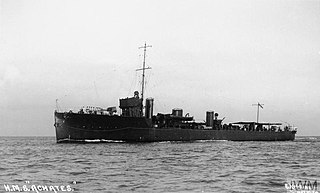
The Admiralty was a department of the Government of the United Kingdom responsible for the command of the Royal Navy until 1964, historically under its titular head, the Lord High Admiral – one of the Great Officers of State. For much of its history, from the early 18th century until its abolition, the role of the Lord High Admiral was almost invariably put "in commission" and exercised by the Lords Commissioner of the Admiralty, who sat on the governing Board of Admiralty, rather than by a single person. The Admiralty was replaced by the Admiralty Board in 1964, as part of the reforms that created the Ministry of Defence and its Navy Department.

Admiral of the Fleet John Rushworth Jellicoe, 1st Earl Jellicoe, was a Royal Navy officer. He fought in the Anglo-Egyptian War and the Boxer Rebellion and commanded the Grand Fleet at the Battle of Jutland in May 1916 during the First World War. His handling of the fleet at that battle was controversial. Jellicoe made no serious mistakes and the German High Seas Fleet retreated to port, at a time when defeat would have been catastrophic for Britain, but the public was disappointed that the Royal Navy had not won a more dramatic victory given that they outnumbered the enemy. Jellicoe later served as First Sea Lord, overseeing the expansion of the Naval Staff at the Admiralty and the introduction of convoys, but was relieved at the end of 1917. He also served as the governor-general of New Zealand in the early 1920s.

Carl Friedrich Heinrich Reinhard Scheer was an Admiral in the Imperial German Navy. Scheer joined the navy in 1879 as an officer cadet and progressed through the ranks, commanding cruisers and battleships, as well as senior staff positions on land. At the outbreak of World War I, Scheer was the commander of the II Battle Squadron of the High Seas Fleet. He then took command of the III Battle Squadron, which consisted of the newest and most powerful battleships in the navy. In January 1916, he was promoted to Admiral and given control of the High Seas Fleet. Scheer led the German fleet at the Battle of Jutland on 31 May – 1 June 1916, one of the largest naval battles in history.
Arthur Joseph Hungerford Pollen was an English journalist, businessman, and commentator on naval affairs who devised a new computerised fire-control system for use on battleships prior to the First World War. His most important technical innovation was one of the world's first electrically-powered analogue computers, patented as the Argo Clock: a differential analyser which enabled big guns to engage with long-range targets when both ships were moving at speed in different directions.

The Harwich Force originally called Harwich Striking Force was a squadron of the Royal Navy, formed during the First World War and based in Harwich. It played a significant role in the war.

United States Battleship Division Nine was a division of four, later five, dreadnought battleships of the United States Navy's Atlantic Fleet that constituted the American contribution to the British Grand Fleet during World War I. Although the U.S. entered the war on 6 April 1917, hesitation among senior officers of the U.S. Navy as to the wisdom of dividing the American battle fleet prevented the immediate dispatch of any capital ships for service in the war zone. Following a direct request from the British Admiralty and a series of high level staff meetings, American opinion changed, and Battleship Division Nine joined the Grand Fleet on 7 December 1917. Within that organization, the Division served as the Sixth Battle Squadron.

The Battle of Dogger Bank on 10 February 1916 was a naval engagement between the Kaiserliche Marine of the German Empire and the Royal Navy of the United Kingdom, during the First World War. Three German torpedo boat flotillas sortied into the North Sea and encountered the British 10th Sloop Flotilla near Dogger Bank. The German vessels eventually engaged the British vessels, after mistaking them for cruisers instead of minesweeping sloops. Knowing they were out-gunned, the British attempted to flee and in the chase, the sloop HMS Arabis was sunk, before the British squadron escaped. As the cruisers of the Harwich Force returned to port, the light cruiser HMS Arethusa struck a mine, ran aground and broke in two. Although the Germans were victorious, they inflated the victory by reporting that they had sunk two cruisers.

The action off Lerwick was a naval engagement on 17 October 1917 fought in the North Sea during the First World War. The German light, minelaying cruisers SMS Brummer and Bremse attacked a westbound convoy of twelve colliers and other merchant ships and their escorts, part of the regular Scandinavian convoy. The two escorting destroyers and nine neutral Scandinavian ships were sunk off Shetland, Scotland.

The convoy—a group of merchantmen or troopships traveling together with a naval escort—was revived during World War I (1914–18), after having been discarded at the start of the Age of Steam. Although convoys were used by the Royal Navy in 1914 to escort troopships from the Dominions, and in 1915 by both it and the French Navy to cover their own troop movements for overseas service, they were not systematically employed by any belligerent navy until 1916. The Royal Navy was the major user and developer of the modern convoy system, and regular transoceanic convoying began in June 1917. They made heavy use of aircraft for escorts, especially in coastal waters, an obvious departure from the convoy practices of the Age of Sail.

HMS Porpoise was an Acasta-class destroyer of the Royal Navy, which was built by Thornycroft between 1912 and 1914. Porpoise served through the First World War, taking part at the Battle of Jutland in 1916, where she was damaged. In 1920, she was sold to the Brazilian Navy serving under the name Alexandrino de Alencar and was renamed Maranhão in 1927. Maranhão remained in service when Brazil entered the Second World War, being used for patrol and convoy duties. She was disposed of in 1945.

The Deputy Chief of the Naval Staff (DCNS) is a senior appointment in the Royal Navy currently held by the Second Sea Lord. The incumbent is usually a three-star rank and had a NATO ranking code of OF-8, but the position has previously been held by an acting two-star ranked officer and a four-star ranked officer.

The Admiralty War Staff was the former senior naval staff operational planning organisation within the British Admiralty that existed from 1912 to 1917. It was instituted on 8 January 1912 by Winston Churchill in his capacity as First Lord of the Admiralty and was in effect a war council whose head reported directly to the First Sea Lord. After the First World War ended, the War Staff was replaced by the Admiralty Naval Staff department.

The Admiralty Naval Staff was the former senior command, operational planning, policy and strategy department within the British Admiralty. It was established in 1917 and existed until 1964 when the department of the Admiralty was abolished. It was replaced by the Ministry of Defence as part of the Ministry of Defence Navy Department.

The Operations Division was a former directorate of the Admiralty Naval Staff responsible for the creation and implementation of long-term policy in regards to the composition of all Royal Navy fleets, squadrons and commands and including operational planning and monitoring from 1912 to 1961.

The Plans Division was the former war preparation and wartime strategic planning arm of the Admiralty Department from 1917 to 1964, The division originally became the main policy advisory and formulating body to the Chief of the Naval Staff. It later came under the supervision of the Assistant-Chief of the Naval staff (Policy).

The Naval Mobilisation Department also known as the Mobilisation and Movements Department was a former department of the British Admiralty initially from 1909 to 1912 and then again from 1918 to 1932. It was mainly responsible for plans, mobilisation and manning during the pre-World War I and post war period.
HMS Christopher was an Acasta-class destroyer of the British Royal Navy. She was built by Hawthorn Leslie in 1911–1912. She served throughout the First World War, forming part of the Grand Fleet until 1916 and taking part in the Battle of Jutland. Later in the war she served in the English Channel to protect merchant shipping against attacks by German U-boats. Christopher was sold for scrap in May 1921.

The Minesweeping Division was a staff division of the Admiralty Naval Staff first established during World War I (1917-1918) the deactivated. It was re-activated during World War II (1939-1943) before being abolished. It was administered by the Director of Minesweeping Division

The Sea Transport Branch of the British Board of Trade, originally established as the Transport Department or Naval Transport Department, was a logistical branch of the Department of Admiralty responsible for the provision of naval transportation services. It underwent numerous name changes throughout its complicated history with responsibility for sea transportation, known as the Department of the Director of Transports from 1890.

HMS Achates was an Acasta -class destroyer of the British Royal Navy. She was built by the Scottish shipbuilder John Brown and was built between 1912 and 1913. Like all Acasta-class destroyers, Achates was armed with three 4-inch (102 mm) guns and two torpedo tubes, with a specified speed of 29 knots.












